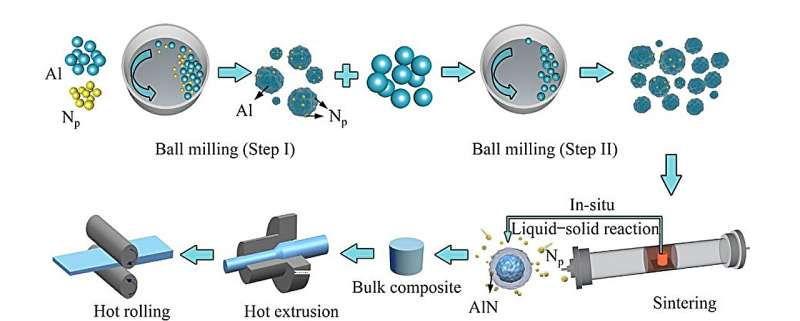Particle-reinforced aluminum matrix composites (PRAMCs), which integrate nanoparticles into an aluminum matrix, show significant promise for aerospace and automotive applications. These composites leverage the benefits of both the aluminum matrix and the reinforcing particles, offering high specific strength, high specific modulus, and excellent wear resistance.
PRAMCs are considered among the most promising and cost-effective materials for enhancing energy efficiency and reducing emissions in the automotive and aerospace sectors. However, the inherent tradeoff between strength and ductility in PRAMCs has historically limited their practical application.
Addressing this persistent challenge, a team of researchers from China, led by Professor Jin-feng Nie and Professor Yong-hao Zhao from the Nano and Heterogeneous Materials Center at Nanjing University of Science and Technology, has developed a novel strategy to enhance the synergy between strength and ductility in PRAMCs. Their findings were published online on May 2, 2024, in the Transactions of Nonferrous Metals Society of China.
Explaining the study’s motivation, Prof. Zhao noted, “Research has shown that the spatial arrangement of reinforcement particles is crucial for enhancing the strength and ductility of PRAMCs. Additionally, introducing a heterogeneous structure within the aluminum matrix, consisting of zones with nanoparticles exhibiting markedly different properties from the bulk material, can significantly improve the mechanical properties of traditional materials.”
To this end, the researchers devised a strategy to improve the mechanical properties of PRAMCs by introducing a heterogeneous structure and controlling the particle configuration.
The team initially fabricated a heterostructured aluminum nitride/aluminum (AlNp/Al) composite using a liquid-solid reaction followed by hot extrusion. This process yielded large clusters of AlNp particles within the Al matrix, which negatively impacted the mechanical properties. To address this, the researchers applied hot rolling to regulate the spatial distribution of particles.
Dr. Nie explained, “During plastic deformation treatments, such as rolling or high-pressure torsion, significant plastic deformation occurs, which can regulate the heterogeneous microstructure.” The hot rolling was performed at 500°C with equivalent strains of 0.7–1.4.
Depending on the equivalent strains, three types of composites were formed with distinct spatial configurations of AlNp: Clustered-AlNp/Al, Networked-AlNp/Al, and Uniformed-AlNp/Al, exhibiting particle distributions as clusters, networks, and uniform dispersions, respectively. Mechanical evaluations revealed that particle refinement led to improved properties.
Notably, the Uniformed-AlNp/Al composite demonstrated yield and tensile strengths of 334.6 and 387.4 MPa, respectively, which were 55 and 52.9 MPa higher than those of the Clustered AlNp/Al composite. Additionally, elongation to failure increased from 6.8% to 9.1%, indicating an exceptional balance of strength and ductility, surpassing previously reported aluminum matrix composites.
The researchers also identified hetero-deformation-induced (HDI) stress, generated due to the different deformation behaviors of the constituent materials, as a key factor in enhancing the strength and ductility of the composite. HDI stress was highest in the Uniformed-AlNp/Al composite.
Prof. Zhao emphasized the study’s significance, stating, “Our strategy provides new insights and guidance for designing composites with superior combinations of strength and ductility.”
Overall, the study’s findings can pave the way for the development of innovative composite materials that enhance the efficiency of automobiles and airplanes while reducing emissions.

Leave a Reply